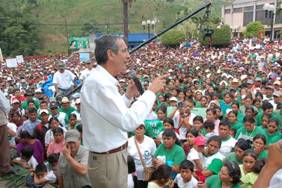by Hal Brands
When discussing narcotics trafficking in the Western Hemisphere there is plenty of room for pessimism. A defense analyst and contributor to American Diplomacy points out another reason for concern.–Ed.
In April of this year, Guatemalan police officers executing a drug bust were ambushed by a group of well-armed and apparently well-trained assailants. Amid a hail of bullets and at least one grenade blast, five policemen were killed and another was wounded.
This incident was soon tied to Los Zetas, the notorious Mexican drug-trafficking organization, and thus added to the long list of attacks carried out recently by Mexican cartels operating on Guatemalan soil. The growing frequency of such events over the past two years raises a disquieting prospect: that the unintended effect of recent counter-narcotics operations in Mexico has been simply to push the cartels south into Guatemala, a country that is in no position to combat this phenomenon or mitigate its deadly consequences.
Experts on the global narcotics trade often refer to something known as the “balloon effect.” Because of the lucrative nature of drug trafficking, they argue, restricting the drug trade in one country merely causes it to spring up in another. The effect is similar to squeezing a balloon—when one part of the balloon is constricted, the air inside simply flows to another part.
The balloon effect has long plagued efforts to combat the inter-American drug trade. When the United States interdicted drug shipments originating in Bolivia and Peru in the 1980s, Colombian traffickers quickly came to dominate the market. After Washington disrupted trafficking routes through the Caribbean a decade later, Mexico and the Eastern Pacific became the new hot spots.
The same dynamic is now evident in Mexico and Guatemala. Since 2005, the Mexican government has launched a major crack-down on drug-trafficking and drug-related violence. First under Vicente Fox, and now under Felipe Calderón, the government has deployed tens of thousands of soldiers as part of “lightning strikes” designed to cripple the major cartels and strangle their illicit commerce.
This offensive has hardly ended the bloodshed in Mexico. Yet it has placed enough pressure on the cartels to make them seek out a more hospitable home—Guatemala. Since roughly 2007, Mexican cartels have steadily expanded their operations in Guatemala. They have set up logistical bases and training camps near the country’s porous northern border and established massive weapons caches on Guatemalan soil. They have begun to compete with local drug bosses for dominance of Guatemalan transit routes; in one shootout, 17 people were killed. Earlier this year, the Zetas brashly announced their presence in the country by threatening to kill President Álvaro Colom.

Guatemala is extremely vulnerable to this sort of penetration. The Guatemalan state is a hollow shell, its credibility destroyed by persistent mass poverty and its institutions crippled by rampant corruption and the legacy of a three-decade civil war. Even before the Mexican cartels moved in, these issues fed into a growing gang problem that gave Guatemala one of the highest murder rates in Latin America and made some areas of the country virtually ungovernable. Guatemala is nominally an electoral democracy; in reality, it is probably closer to a failed state.
The Mexican connection thus adds a volatile new element to an already combustible situation. Violence between Mexican and Guatemalan traffickers will only increase as the Mexicans set up shop, and the presence of the Zetas especially could have dire implications for internal stability. The Zetas are known for assassinating police officers and public officials in Mexican towns they seek to control, and there is little reason to think that they will not employ these tactics in Guatemala as well. For a country that already suffers from alarming levels of criminal violence, the arrival of the Mexican cartels will only make matters worse.
Unfortunately, there is little relief in sight for Guatemalans. The police and military are beset by ineffectiveness and corruption, and these tendencies will only become more pronounced if groups like the Zetas have anything to say about it. The United States has pledged $10-20 million in annual counter-narcotics assistance over the next three years, but this sum will hardly make a dent in the institutional deficiencies that abet drug-related crime in Guatemala. Given the situation in Mexico, the recent coup in Honduras, as well as the fact that the United States is currently fighting two wars, it seems unlikely that Guatemala will soon receive substantially greater attention or aid from Washington. Finally, to the extent that the Mexican government is successful in its own fight against the cartels, it may simply push the problem south, further increasing the pressure on its neighbor.

Hal Brands is the author of From Berlin to Baghdad: America’s Search for Purpose in the Post-Cold War World. He is a defense analyst in Washington, D.C.
